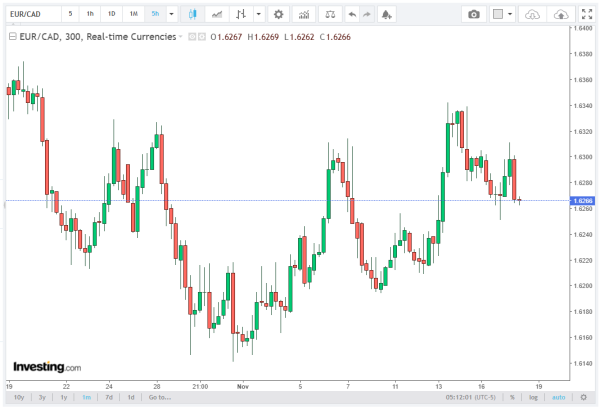EUR/CAD Struggles Amid BoC Caution
The EUR/CAD currency pair continues its losing streak, marking the third consecutive session of declines. After erasing earlier daily gains, the cross is trading near 1.6260 during European hours on Tuesday.
The depreciation comes as the Canadian Dollar (CAD) strengthens on a cautious tone surrounding the Bank of Canada (BoC) policy outlook. The LFtrade team provides a complete and thoughtful breakdown of this matter in their article.
Investors are closely monitoring the BoC for signals on interest rate decisions and monetary policy direction. Although Canada’s annual inflation moderated to 2.2% in October, core inflation measures tracked by the BoC remain close to 3%, suggesting that underlying price pressures are still present.
Combined with robust labour market data, including an unemployment rate of 6.9% and wage growth of around 4%, the BoC appears likely to maintain a cautious stance. Consequently, market expectations have shifted toward stable interest rates, with forecasts indicating that the BoC may keep rates unchanged through the end of 2026.
Commodity-Linked CAD Faces Headwinds
Despite recent gains, the commodity-linked Canadian Dollar (CAD) may face renewed downward pressure amid softer crude oil prices. West Texas Intermediate (WTI) crude has stalled its three-day rally, slipping to roughly $59.60 per barrel.
Oil prices are retreating as markets grapple with growing worries over excess supply. According to ING, a notable surplus could persist well into 2026, potentially weighing on prices for an extended period. Goldman Sachs similarly warned that ramped-up production might sustain an oversupply of around 2 million barrels per day, reinforcing the downward pressure on the market.
Euro Finds Support Amid ECB Caution
On the Euro (EUR) side, EUR/CAD could find technical support as investors remain cautious about the ECB’s near-term monetary policy outlook. The European Central Bank (ECB) is widely expected to keep interest rates unchanged, supported by stable economic performance and inflation close to target levels.

ECB Governing Council Member Olli Rehn recently emphasized the importance of vigilant monitoring, noting that while inflation risks may be slowing, upside risks remain. He also stressed the need for strong banking buffers and a careful policy stance, signaling that the ECB may act conditionally rather than aggressively.
Further commentary from ECB policymaker Olaf Sleijpen indicated that a run on stablecoins could necessitate monetary policy adjustments to protect financial stability. Such remarks underline the ECB’s cautious approach, which could provide the Euro with support against commodity-linked currencies like the CAD.
Technical Levels and Market Implications
From a technical perspective, EUR/CAD has fallen through multiple intraday support levels, now eyeing the 1.6250 zone. Should CAD strength continue amid BoC caution, the cross may test 1.6200, a key psychological and technical support level.
Conversely, a rebound in crude oil prices or renewed Euro optimism could allow the cross to recover toward 1.6300–1.6350, where previous resistance levels remain intact. Traders are advised to monitor volatility in WTI oil, BoC communications, and ECB commentary, as these factors are likely to influence EUR/CAD price dynamics in the near term.

Market Sentiment and Outlook
Overall, EUR/CAD dynamics are currently shaped by a mix of central bank caution and commodity market fluctuations. The Canadian Dollar benefits from solid domestic economic fundamentals, but commodity headwinds may limit further gains. Meanwhile, the Euro continues to find support from cautious ECB guidance, preventing a more pronounced decline.
Investors should remain attentive to upcoming economic data releases, particularly Canadian labour and inflation figures, and Eurozone inflation updates. These releases could trigger short-term volatility in EUR/CAD, potentially creating trading opportunities for technical and fundamental strategists.
Conclusion
In summary, EUR/CAD is under pressure near 1.6250, largely due to a cautious BoC stance, despite underlying inflationary pressures and solid labour market metrics. The CAD may face resistance from softening oil prices, while the Euro is supported by measured ECB commentary and stable economic conditions.
Key market drivers for the upcoming sessions will be closely tied to central bank decisions, commodity trends, and economic indicators. The Bank of Canada (BoC) interest rate expectations and any accompanying policy guidance are likely to heavily influence CAD currency movements and broader risk sentiment, as traders anticipate potential tightening or easing measures.
Meanwhile, crude oil price trends, with particular attention to WTI movements, will remain a critical factor, affecting energy stocks, commodity-linked currencies, and overall market volatility.
Additionally, ECB communications and Eurozone economic data, such as inflation, GDP, and employment figures, will be closely monitored for insights into the future of monetary policy and its impact on the euro and European financial markets. These factors together are expected to create heightened trading opportunities and potential market swings in the coming sessions.










